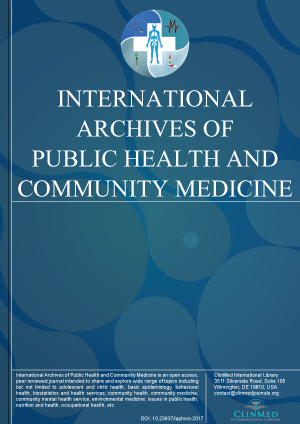Open Access DOI:10.23937/2643-4512/1710092
Birth and Death Rates, and Causes of Death among the General Population in Kono District, Sierra Leone, 2020-2021
Ivan Augustine Barrie, Babatunde Duduyemi, Solomon Aiah Sogbeh, Philip Gevao, Adel Hussein Elduma and Gebrekrstos Negash Gebru
Article Type: Original Article | Indexed Archive: Volume 7
Civil registration is the most effective way to keep track of all births and deaths. Despite the existence of the Birth and Death Act (1983), Sierra Leone registers 93% of births and only 57% of deaths annually. To provide more accurate inter-census population estimates, we estimated the birth and death rates, registration distribution, and causes of death for Kono District population in Sierra Leone....
Open Access DOI:10.23937/2643-4512/1710091
Bridging the Gap to Health Care Access: The Role of the Nurse Practitioner
Kimberly Taylor
Article Type: Research Article | Indexed Archive: Volume 7
The goal of this article review is to explore the role of Nurse Practitioners (NP) in closing the gap to health care access for underserved communities. It will address their role as clinical provider, educator, and advocate for programs to improve community outcomes. Nurse Practitioners through additional education and professional training are licensed to provide health care directly to patients. As an educator, Nurse Practitioner spend hours of educating patients on treatment plans, medicatio...
Open Access DOI:10.23937/2643-4512/1710090
Examining the Intersection of Seva and Public Health Policy
Pragat Patel
Article Type: Research Article | Indexed Archive: Volume 7
In today's globalized and multifaceted world, policymakers are faced with the challenge of crafting policies that cater to the diverse needs of different communities. One approach that has shown promise in achieving this goal is the Hindu concept of seva or selfless service. Seva involves the selfless act of serving others without any expectation of reward or recognition. Rather, the motivation is behind serving God through serving humanity. This principle has deep roots in Hindu culture and has...
Open Access DOI:10.23937/2643-4512/1710089
Reimagining Health Policy through the Lens of Vedanta
Pragat Patel
Article Type: Research Article | Indexed Archive: Volume 7
The philosophical system of Vedanta has had a profound influence on Hindu thought and practice, and we can explore its relevance in shaping contemporary health policy. As one of the six orthodox schools of Hindu philosophy, Vedanta is based on the teachings of the Upanishads, which explore fundamental questions about the nature of reality and the self. By examining key concepts and principles from Vedanta philosophy, this ancient wisdom can offer valuable insights into the limitations....
Open Access DOI:10.23937/2643-4512/1710075
Non-COVID-19 Deaths in Times of Pandemic: Lessons Learned
Lodys Loreth López-Mosquera, Andrea Carolina Hurtado-Moreno, Faudy Jholey Puerta-Londoño, Valeria Vela-López, Lizeth Lorena Davila-Maya and Michael Gregorio Ortega-Sierra
Article Type: Editorial | Indexed Archive: Volume 6
The actual distribution of excess mortality throughout the world from the ravages of the COVID-19 pandemic remains a question mark. Deaths from COVID-19 and non-COVID causes, decompensation of previous illnesses, complications of acute illnesses, and loss of functional capacity due to progression of chronic and degenerative diseases have exacted an unparalleled toll on health care systems. Similarly, it has increased the global burden of disease and compromised the quality of human life in the m...
Open Access DOI:10.23937/2643-4512/1710074
Effects of Workplace Configurations on Frontline Physiotherapists in Public and Private Hospitals in Brazil during the Covid-19 Pandemic
Rodrigo Gonçalves dos Santos, Arlindo Souza Amaral Neto, Mônica Ferreira da Silva, Paulo Victor Rodrigues de Carvalho and Alessandro Jatobá
Article Type: Original Article | Indexed Archive: Volume 6
The work of physiotherapists in handling Covid-19 patients depends on the severity of the patient condition. These workers rely on adequate workplaces, especially Intensive Care Units (ICU), where critical patients are handled. Private and public hospitals in Brazil dealt differently with the demands imposed by the Covid-19, and consequently, workers in public and private hospitals had to rely on distinct working conditions. Thus, this article aims to identify the possible risks, and the effects...
Open Access DOI:10.23937/2643-4512/1710073
A Prescription Refill Intervention to Improve Patient and Physician Satisfaction
Daniel P. Dunham, MD, MPH and Christopher Cheney, MHA
Article Type: Original Article | Indexed Archive: Volume 6
Physician burnout has been increasing over the past decades. This phenomenon is found throughout the world and is multifactorial. Some causes are easily identified and treatable. Of the remedial causes, improved practice efficiency is one that deserves attention. Time spent directly with patients will always be a core component of health care. Provider time spent away from direct patient care is often a cause of frustration and should be minimized. High quality communication between patients and...

